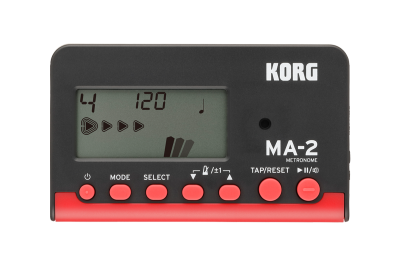As a school band director, teaching beginner players, I am constantly asked by parents what items their children really need to get started. There are a few key recommendations that I make, regardless of what instrument their child plays. First, they need a reliable instrument (we’ll talk about that in another blog, another day). Second, they should have a music stand (again, there are so many out there, that maybe this will be a blog sometime too…but basically, a music stand that they can use at home for practice sessions is important because it encourages good posture). Third—and this is a big one—is a metronome. There isn’t a band student on the planet—as far as I am concerned—that should be without one of these fantastic devices. Why?
#1: Counting Rhythms is Tricky Business, and a Metronome Helps!
A metronome can help students to understand rhythmic counting. This is a really difficult task for so many students—and even though some students pick up the “basics” relatively easily, there will come a point where it is very beneficial to have that little ticking box—the metronome—helping us to figure out how to count eighth notes, sixteenth notes, and beyond. Counting rhythms is not something that band students should breeze past without really grasping.
#2: A Metronome Helps Students to Avoid the Tendency to Rush.
Even when they are just starting out, it is important to avoid inadvertent tempo fluctuations. Simple rhythms may be “easy” to count aloud – but a metronome will help them to be counted steadily, on the beat. Simple rhythms are often rushed by beginner players, and a metronome will help these students to avoid rushing ahead. Without a metronome, many students won’t even believe that they are speeding up, but there’s no denying it when a metronome is used for accountability. And conversely, many students don’t realize consciously that they are slowing way down, or developing a very irregular tempo, when they attempt to play difficult passages in their music. Basically, metronomes keep us honest (and really, that applies to all musicians…not just the kids)!
#3: Scale & Rudiment Exercises with a Metronome Allow Students to Gauge Progress.
It’s hard to track gradual progress over time without a measurable system of evaluation. A metronome is to a beginner band student what a scale is to a dieter. Basically, they can track their ability to play rudiments and scale exercises at faster tempos by making a note of where they were at the start, and then noting how much faster they can perform those exercises each week.
As far as what metronome to purchase, there’s certainly an array of options. Paul Effman Music Store carries a large inventory of metronomes, and within that selection, my top pick is the Korg MA-2.  The Korg MA-2 is a digital metronome with an easy-to-hear tap tempo function, and LCD pendulum, 13 built-in rhythms, 12 pitches, a tempo range of 40-208 beats per minute, memory backup, and an earphone jack. I always recommend getting a metronome with an earphone jack because depending on where you are playing or how loud you are playing, it can be hard to hear the taps. The Korg MA-2 will also appeal to students because it is in a fun shade of blue, and it’s small enough to fit in many instrument cases (depending on what they play, of course) – it’s about the size of a cassette tape.
The Korg MA-2 is a digital metronome with an easy-to-hear tap tempo function, and LCD pendulum, 13 built-in rhythms, 12 pitches, a tempo range of 40-208 beats per minute, memory backup, and an earphone jack. I always recommend getting a metronome with an earphone jack because depending on where you are playing or how loud you are playing, it can be hard to hear the taps. The Korg MA-2 will also appeal to students because it is in a fun shade of blue, and it’s small enough to fit in many instrument cases (depending on what they play, of course) – it’s about the size of a cassette tape.
